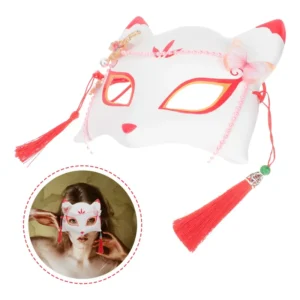Kitsune masks have gained immense popularity, particularly at Japanese festivals, where they embody a rich cultural and historical tradition. Rooted in folklore, Kitsune masks are cherished symbols of Japan’s deep connection to its past.
Many people wonder, “What do Kitsune masks represent?” The answer lies in their depiction of mysterious fox spirits with supernatural powers, often viewed as messengers of the gods.
In this article, we’ll explore the fascinating significance of Kitsune masks in Japanese culture, their symbolism, and their role in festivals and traditions.
What Do Kitsune Masks Represent?
The Kitsune mask represents the fox spirit (kitsune) in Japanese culture. These masks are deeply intertwined with mythology, symbolizing wisdom, protection, spirituality, transformation, and duality. Whether portraying benevolent or malevolent fox spirits, Kitsune masks carry rich stories and meanings.
From ancient folklore to modern festivals, Kitsune masks remain a vibrant part of Japanese heritage. Let’s explore their deeper meanings and how they bridge tradition and creativity.
1. Kitsune Masks in Japanese Folklore
In Japanese folklore, Kitsune are supernatural fox spirits believed to possess mystical powers, including the ability to shapeshift. They are often depicted as messengers of the Shinto deity Inari, the god or goddess of fertility, prosperity, and agriculture. These fox spirits are said to guide and protect their followers, warding off evil forces.
Shapeshifting Abilities
Kitsune’s ability to shapeshift, often into human forms, is one of their most famous traits. They can disguise themselves as men or women, often weaving tales of deception or wisdom. While the shapeshifting seen in movies may be fictional, folklore holds countless stories of Kitsune influencing the human world with their transformative powers.
2. A Spiritual Connection with Foxes
In Japanese culture, foxes are not just animals but revered beings believed to bridge the spiritual and natural worlds. This connection is reflected in Kitsune masks, which symbolize this harmony.
Foxes are seen as protectors, communicators, and sometimes tricksters, embodying the duality of nature—good and evil, creation and destruction. These attributes make them central figures in Japanese spirituality and artistic expression.
3. Kitsune Masks as Traditional Art
Kitsune masks are celebrated as traditional Japanese art. From historical plays to modern performances, these masks capture the essence of folklore. They are carefully crafted to reflect the mysterious and multifaceted nature of Kitsune, often showcasing intricate details that highlight their mystical abilities.
In theatrical and storytelling traditions, performers use Kitsune masks to portray shapeshifting foxes, enchanting audiences with their tales of mystery and wonder.
4. Kitsune Masks in Festivals and Celebrations
Kitsune masks are an integral part of Japanese festivals, especially those with Shinto origins. During these celebrations, wearing a Kitsune mask is seen as a way to honor fox spirits and invite their protection and blessings.
Festivals like the Oji Kitsune-no-Gyoretsu (Fox Parade) in Tokyo celebrate these fox spirits with vibrant displays, where people don masks to reenact folkloric tales and connect with their heritage.
5. Designs and Variations of Kitsune Masks
Kitsune masks come in various designs and colors, each symbolizing a unique aspect of fox spirits. Below are some common variations:
- White Kitsune Mask: Symbolizes Inari and offers protection.
- Red Kitsune Mask: Represents strength, protection, and the ability to ward off evil spirits.
- Black Kitsune Mask: Signifies mystery and wealth.
- Nine-Tailed Fox Mask: A rare design symbolizing immense wisdom and supernatural power, representing the legendary kyūbi no kitsune (nine-tailed fox).
Each design carries specific meanings, reflecting the versatility and depth of Kitsune mythology.
Conclusion
Kitsune masks are more than just decorative items; they are gateways to Japan’s rich cultural and spiritual heritage. From their roots in folklore to their role in festivals, these masks symbolize protection, transformation, and wisdom. Wearing a Kitsune mask is a way to honor the mystical fox spirits and celebrate Japan’s enduring traditions.
Whether you’re drawn to their spiritual symbolism or their artistic beauty, Kitsune masks continue to captivate people worldwide, serving as reminders of Japan’s vibrant history and culture.
FAQs
What do Kitsune masks represent in Japanese culture?
Kitsune masks symbolize the fox spirit in Japanese culture. They represent wisdom, duality, spirituality, and protection, reflecting the multifaceted nature of Kitsune folklore.
Why are Kitsune masks worn at festivals?
Kitsune masks are worn during festivals to honor fox spirits and their connection to Shinto traditions. They are particularly popular in celebrations dedicated to Inari, the deity of fertility and prosperity.
What do the different colors of Kitsune masks signify?
White Kitsune Mask: Protection and association with Inari.
Red Kitsune Mask: Strength and the ability to fight evil.
Black Kitsune Mask: Mystery and wealth.
Nine-Tailed Fox Mask: Wisdom and extraordinary supernatural abilities.
What is the spiritual significance of Kitsune masks?
Kitsune masks honor fox spirits that are believed to bring protection, fertility, and guidance. They are also used in rituals and festivals to ward off negative energies.




